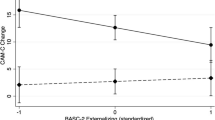Abstract
We investigated the use of a popular measure, the Children and Adolescent Functional Assessment Scale (CAFAS), in treatment outcome research. The sample included 70 children who had been discharged from an elementary therapeutic classroom (Intensive Mental Health Program). Significant relationships were found between decreases in CAFAS scores and optimal educational placement, contributing to evidence of the scale’s discriminant validity. Clinically significant change in CAFAS scores was also investigated, with a 30 point change in score most accurately discriminating between placements after discharge. Further investigations of real world outcomes versus changes in score on this measure are warranted.




Similar content being viewed by others
References
Bates, M. (2001). The Child and Adolescent Functional Assessment Scale (CAFAS): Review and current status. Clinical Child and Family Psychology Review, 4, 63–84.
Canino, G., Costello, E. J., & Angold, A. (1999). Assessing functional impairment and social adaptation for child mental health services research: A review of measures. Mental Health Services Research, 1, 93–108.
Finger, M. S., & Rand, K. L. (2003). Addressing validity concerns in clinical psychology research. In M. C. Roberts, & S. S. Ilardi (Eds.), Handbook of research methods in clinical psychology (pp. 13–30). Malden, MA: Blackwell.
Hodges, K. (2000). Child and adolescent functional assessment scale (3rd ed.). Ypsilanti, MI: Eastern Michigan University.
Hodges, K., Doucette-Gates, A., & Liao, Q. (1999). The relationship between the child and adolescent functional assessment scale (CAFAS) and indicators of functioning. Journal of Child and Family Studies, 8, 109–122.
Hodges, K., Xue, Y., & Wotring, J. (2004). Use of the CAFAS to evaluate outcome for youths with severe emotional disturbance served by public mental health. Journal of Child and Family Studies, 13, 325–339.
Hsu, L. M. (1999). Caveats concerning comparisons of change rates obtained with five methods of identifying significant client changes: Comment on Speer and Greenbaum (1995). Journal of Consulting and Clinical Psychology, 67, 594–598.
Jacobson, N. S., & Truax, P. (1991). Clinical significance: A statistical approach to defining meaningful change in psychotherapy research. Journal of Consulting and Clinical Psychology, 59, 12–19.
Jenson, C. E., Turner, W., Amero, S., Johnson, A., & Werrbach, G. (2002). Predicting resource utilization by children with serious emotional disturbance and their families. Journal of Child and Family Studies, 11, 361–371.
Kazdin, A. E. (1998). Research design in clinical psychology (3rd ed.). Boston: Allyn and Bacon.
McGlinchey, J. B., Atkins, D. C., & Jacobson, N. S. (2002). Clinical significance methods: Which one to use and how useful are they? Behavior Therapy, 33, 529–550.
Speer, D. C., & Greenbaum, P. E. (1995). Five methods for computing significant individual client change and improvement rates: Support for an individual growth curve approach. Journal of Consulting and Clinical Psychology, 63, 1044–1048.
Vernberg, E. M., Roberts, M. C., & Nyre, J. E. (2002). School-based intensive mental health treatment. In D. T. March, & M. A. Fristad (Eds.), Handbook of serious emotional disturbances in children and adolescents (pp. 412–427). New York: Wiley.
Vernberg, E. M., Roberts, M. C., & Nyre, J. E. (2007a). The Intensive Mental Health Program: Development and structure of the model of intervention for children with serious emotional disturbances. Journal of Child and Family Studies, doi: 10.1007/s10826-007-9157-y.
Vernberg, E. M., Roberts, M. C., Nyre, J. E., Jacobs, A. K., & Randall, C. J. (2007b). Outcomes and findings of program evaluation for the Intensive Mental Health Program. Journal of Child and Family Studies, doi: 10.1007/s10826-007-9158-x.
Author information
Authors and Affiliations
Corresponding author
Rights and permissions
About this article
Cite this article
Roy, K.M., Roberts, M.C., Vernberg, E.M. et al. Measuring Treatment Outcome for Children with Serious Emotional Disturbances: Discriminant Validity and Clinical Significance of the Child and Adolescent Functioning Assessment Scale. J Child Fam Stud 17, 232–240 (2008). https://doi.org/10.1007/s10826-007-9162-1
Published:
Issue Date:
DOI: https://doi.org/10.1007/s10826-007-9162-1



